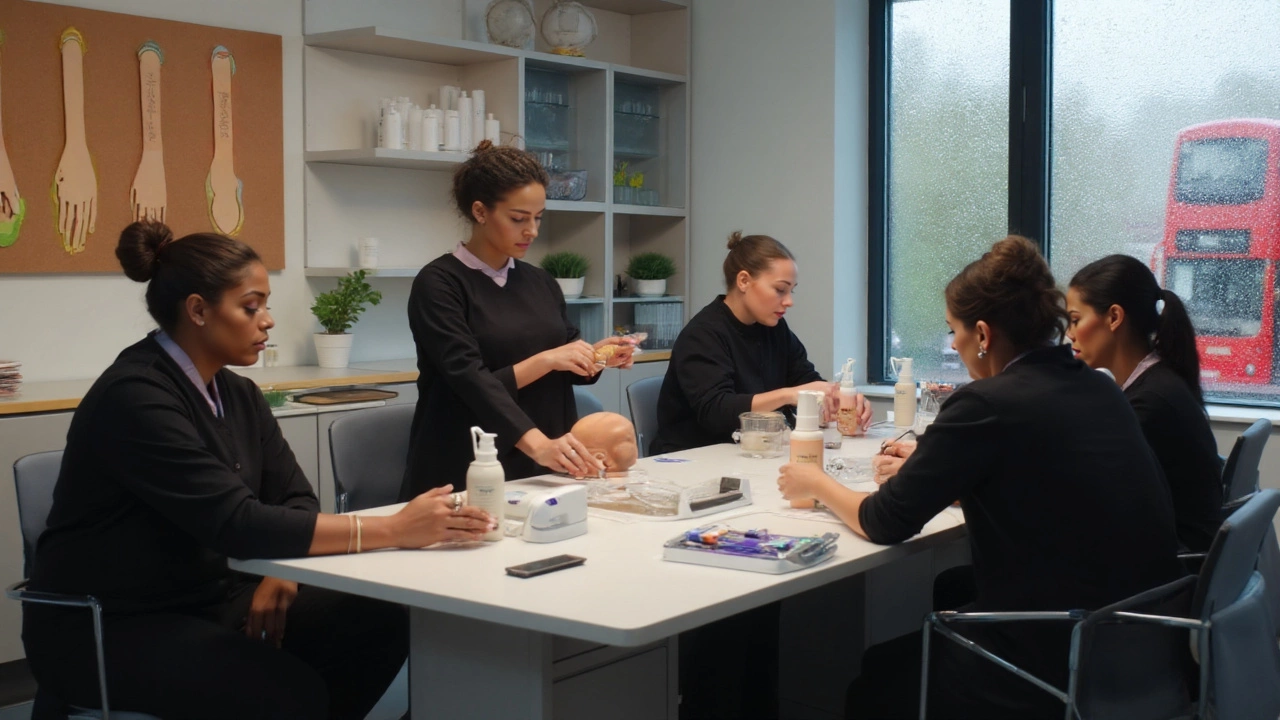If you’re asking what the “best qualification” is for a beauty therapist in the UK, you’re really asking two things: what gets you hired fast and what sets you up for bigger treatments and better pay. Here’s the honest bit. For most salon jobs in England in 2025, the gold standard is a regulated Level 3 Beauty Therapy qualification (typically VTCT or City & Guilds), ideally on top of Level 2. If you want global recognition, look at CIBTAC or CIDESCO. If you want to do laser, skin needling, or semi-permanent makeup, you’ll need Level 4+ on top of Level 3. Those are the lanes. Pick one that matches where you want to work and how far you want to go.
- best qualification for a beauty therapist in the UK (for employment + insurance): Level 3 Beauty Therapy (VTCT/City & Guilds/ITEC), ideally after Level 2.
- Best international recognition: CIBTAC or CIDESCO (great for cruise ships or working abroad).
- Best for advanced/aesthetics: Level 4+ (Laser & IPL, microneedling, microblading) after Level 3.
- Fastest paid route: Apprenticeship (Level 2 then Level 3) if you want to earn while learning.
- Watch-outs: Must be Ofqual-regulated, enough practical hours, live assessments, and insurer-approved units.
What “best” really means in UK beauty therapy (2025)
“Best” depends on your goal. Employers and insurers in the UK care about regulated qualifications, enough hands-on hours, and current safety units. The safest all-round pick for most people is a Level 3 Beauty Therapy from VTCT or City & Guilds (or ITEC, which is part of VTCT). It’s widely recognized, sits on the Regulated Qualifications Framework (RQF), and ticks the boxes insurers look for.
Here’s how the levels break down in the UK:
- Level 2 (GCSE level): Core salon skills - facials, waxing, manicure/pedicure, basic makeup, reception, health & safety.
- Level 3 (A-level equivalent): Advanced techniques - body massage, electrical facials, body electricals, advanced waxing, hot stones, aromatherapy (optional), plus business and client care.
- Level 4+ (post-18 specialist): Laser & IPL, skin needling, chemical peels, microblading/PMU, and advanced skin science. Often required by insurers and councils for non-surgical cosmetic work.
Key UK realities in 2025:
- Regulation: Ofqual regulates qualifications in England on the RQF. Sticking with regulated awards protects you with employers and insurers.
- Insurance: Major insurers (e.g., BABTAC, ABT, Professional Beauty Direct) usually require Level 2/3 for core treatments and Level 4+ for advanced work. They also look for treatment-specific CPD.
- Licensing: Laser, IPL, and micropigmentation often need local council licensing. The government has consulted on a national aesthetics licensing scheme; more rules are expected during 2025-26. Plan for Level 4+ if you want to do any higher‑risk work.
- Awarding bodies: VTCT is the UK heavyweight. City & Guilds is well known. ITEC sits under VTCT. CIBTAC and CIDESCO carry strong international weight.
So, what’s “best” for you?
- If you want solid UK employability: Level 3 Beauty Therapy (VTCT/City & Guilds/ITEC), usually after Level 2 or via an extended Level 3 that includes Level 2 content.
- If you want global movement (cruise ships, overseas spas): CIBTAC or CIDESCO (often on top of Level 3 or as an integrated path).
- If you want to offer advanced treatments: Level 4+ in that treatment area after Level 3.
Quick definitions that trip people up:
- NVQ vs Diploma vs Certificate: These refer to the structure and size of the qualification. An NVQ tends to be work-based with on-the-job evidence; a Diploma is broader with more units; a Certificate covers fewer units. For employers/insurers, the key is the level, the awarding body, and the units covered.
- Apprenticeship vs college/private course: An apprenticeship is a job plus training with an End-Point Assessment; a college/private course is classroom-clinic based with assessments throughout. Both can lead to Level 2 and Level 3.
Step-by-step: pick the right route and get qualified
Use this as a simple playbook to go from zero to hireable, then to advanced.
-
Decide your endgame. Where do you want to work in 12-24 months?
- High-street salon/spa: Aim for Level 2 + Level 3 (VTCT/City & Guilds/ITEC).
- Cruise ships/luxury spas abroad: Add CIBTAC or CIDESCO to stand out.
- Advanced/aesthetics: Plan for Level 4+ after Level 3.
-
Pick your route to train. Three common paths:
- Further Education (FE) college: Often free for 16-18. Adults can use an Advanced Learner Loan. Good clinic time, slower pace (1 academic year per level).
- Private training provider: Faster (weeks/months), smaller groups, higher fees. Great if you’re a career changer wanting speed.
- Apprenticeship (paid job + training): Earn while you learn. Level 2 takes ~12 months, Level 3 another 15-24 months. You need an employer to sign you.
-
Verify the qualification is regulated and accepted. Check:
- Awarding body: VTCT, City & Guilds, ITEC, CIBTAC, CIDESCO.
- Ofqual regulation (for England) or equivalent (Qualifications Wales, SQA, CCEA).
- Units included match your goal: e.g., electrical facials, massage, hot stones, electrotherapy, advanced waxing, etc.
- Delivery includes real client clinic hours and live assessments, not just online theory.
-
Start with Level 2 (unless your Level 3 integrates it). Expect:
- Guided Learning Hours: roughly 300-400 GLH.
- Duration: 12-24 weeks (private fast-track) or 1 academic year (college, part-time).
- Core treatments: basic facials, waxing, manicure/pedicure, lash/brow, reception, health & safety.
-
Progress to Level 3. This is the employability booster:
- GLH: roughly 400-600 depending on optional units.
- Duration: ~16-30 weeks private or 1 academic year college.
- Typical units: body massage, electrical facials, body electricals, stone therapy, aromatherapy (optional), microdermabrasion (varies).
-
Add Level 4+ if you want higher-end treatments. Examples:
- Laser & IPL: Level 4 plus Core of Knowledge and council licence where required.
- Skin needling, chemical peels: Level 4/5 depending on the awarding body and insurer policy.
- Microblading/PMU: Level 4 plus local licensing (special treatments licence in many councils).
-
Sort insurance and hygiene training. After Level 2 or 3, get professional insurance before treating the public. Add Infection Control, Anaphylaxis First Aid, and Sharps Safety if doing advanced treatments.
-
Build a portfolio and get references. Keep treatment logs, photos (with consent), client feedback, and notes on contraindications handled. This helps with jobs and insurance renewals.
Pitfalls I see all the time:
- Buying “instant” online certificates for hands-on treatments. If there’s no supervised clinic time, insurers may reject it.
- Assuming any Level 3 is equal. Check units. Some Level 3s skip electricals or body massage unless you choose them.
- Skipping health & safety. Patch testing, contraindications, and record keeping are not optional.
- Chasing advanced courses without a Level 3 base. Many providers and insurers won’t accept you for Level 4 without it.

Comparisons and trade-offs that actually matter
Different awarding bodies and routes suit different goals. Use these practical comparisons.
| Option | What it is | Recognition | Typical Duration | Good for | Watch-outs |
|---|---|---|---|---|---|
| VTCT Level 3 Beauty Therapy | UK-regulated diploma/NVQ with advanced units | High in UK; accepted by major insurers | 16-30 weeks private; 1 year college | Salon jobs, insurance, progression to Level 4 | Check unit mix (ensure electricals/massage if needed) |
| City & Guilds Level 3 Beauty | UK-regulated Level 3 via FE colleges/private | High in UK; insurers recognise | Similar to VTCT timings | Employment in salons/spas | Content varies by centre; verify practical hours |
| ITEC Level 3 | Internationally known; part of VTCT group | Strong UK/EU recognition | Similar to VTCT | Working across borders | As always, confirm units for insurer acceptance |
| CIBTAC Diploma | International diploma with rigorous standards | High global recognition | Usually 6-12 months (varies) | Cruise ships, high-end spas, overseas | More demanding exams; often pricier |
| CIDESCO Diploma | Prestigious international diploma | Top-tier global recognition | 9-12+ months incl. salon hours | Luxury/medical spa settings | Longer commitment; selective centres |
| Apprenticeship (L2→L3) | Paid job + training with EPA | Employers value real experience | 2-3 years total | Earn while you learn, strong employability | Slower to advanced; employer availability |
Costs and time are real constraints. Here’s a simple UK benchmark so you can plan:
| Level/Route | Typical Fees (Private) | College Fees (Adults) | Funding Options | Time to Complete |
|---|---|---|---|---|
| Level 2 Beauty | £1,500-£3,000 | £0 with concessions or £1,000-£3,000 | Advanced Learner Loan (adults), free for 16-18 | 12-24 weeks private; 1 year college |
| Level 3 Beauty | £1,800-£3,500 | £0-£3,500 depending on age/funding | Advanced Learner Loan; employer support | 16-30 weeks private; 1 year college |
| Level 4 Laser/IPL | £1,800-£4,000 | Limited college options; mostly private | Self-funded or employer-funded | 4-12 weeks part-time + case studies |
| Apprenticeship (L2→L3) | £0 for learner (employer/training funded) | £0 | Government/employer-funded | 24-36 months including EPA |
Hiring realities (based on what UK salon owners tell me):
- Level 3 with massage and electrical facials is the sweet spot for day-one value.
- Speed isn’t everything. Managers prefer fewer certificates with more real clinic hours.
- If you bring social proof (before/after photos, client feedback), you jump the queue.
Scenarios to help you decide fast:
- School leaver (16-18): College Level 2 → Level 3. Consider an apprenticeship if you want to earn.
- Career changer (25-40): Private fast-track Level 2 → Level 3 within 6-12 months; portfolio on Instagram; interview with treatment logs.
- Going abroad or cruise ships: Add CIBTAC or CIDESCO after Level 3. Cruise recruiters love those names.
- Self-employed studio with advanced services: Level 3 first, then Level 4 in laser/skin needling/PMU, plus council licence and robust insurance.
Insurance acceptance checklist (UK):
- Is the qualification regulated (Ofqual/RQF) or a recognised international diploma? Yes → Good.
- Does it include supervised practicals and live assessment? Yes → Good.
- Does it explicitly cover the treatment you want to insure? Yes → Good. If not, add a treatment-specific certificate from a recognised provider.
Checklists, mini‑FAQ, and your next steps
Use these quick checklists to avoid bad buys and keep you on track.
Provider due‑diligence (10‑minute check):
- Awarding body listed (VTCT, City & Guilds, ITEC, CIBTAC, CIDESCO).
- Ofqual qualification code shown (or relevant national regulator).
- Guided Learning Hours stated and realistic (L2 ~300-400, L3 ~400-600).
- Minimum practical client numbers (ask: “How many real clients will I treat?”).
- Assessment type: live observations, theory exams, case studies.
- Tutor CVs (recent industry experience, not just teaching quals).
- Insurance partners listed (or written confirmation of acceptability).
- Clear refunds, re-sit fees, and model policies.
Unit selection tips (don’t skip these if you want to be hireable):
- Level 2: Waxing, manicure/pedicure, basic facials, lash/brow, health & safety.
- Level 3: Body massage and electrical facials are employer magnets. Add advanced waxing and stone therapy if available.
- Planning laser/skin needling later? Choose units with skin analysis and electricals now. It makes Level 4 smoother.
Mini‑FAQ
- Can I skip Level 2 and go straight to Level 3? Some centres offer an “extended Level 3” that includes Level 2 content. If not, most will expect Level 2 first.
- Are online‑only beauty courses valid? Not for hands‑on work. Insurers expect supervised practicals and live assessments.
- How long to become job‑ready? Fast track: 6-12 months to get Level 2 + Level 3 via private providers. College route: two academic years. Apprenticeship: ~2-3 years while earning.
- Do I need GCSEs? Helpful for college entry, but private providers may accept a skills assessment. Your practical performance matters more.
- What about pay? Entry-level salon roles often sit around £18k-£23k in the UK, rising with tips, commission, and advanced treatments. Self-employed can earn more per hour with strong rebooking and retail.
- Is CIDESCO/CIBTAC worth it? If you want cruise ships or high-end international spas, yes. For local UK salons, Level 3 (VTCT/City & Guilds/ITEC) is usually enough.
- What’s changing in 2025? The government has been moving toward a national licensing scheme for non-surgical cosmetics. Expect Level 4+ to become the baseline for higher-risk treatments like laser and needling.
Simple decision guide
- If you want the safest, hireable choice: VTCT or City & Guilds Level 3 Beauty Therapy.
- If you want global credibility: CIBTAC or CIDESCO added to (or integrated with) Level 3.
- If you want advanced skins/laser: Level 3 first, then a recognised Level 4 in your chosen modality.
Next steps (pick your lane):
- School leaver: Apply to your local FE college for Level 2 starting this term; ask about progression to Level 3 and work placements.
- Career changer: Shortlist two private centres with strong clinic hours; book Level 2 then Level 3 back-to-back; start building a portfolio on social.
- Already Level 2: Enrol onto Level 3 with units in massage and electrical facials. Keep a treatment log for interviews.
- Planning laser/PMU: Finish Level 3, then book a Level 4 with Core of Knowledge. Speak to your council about licensing before you invest.
Troubleshooting
- Struggling with models? Ask providers if they supply models; join local Facebook groups; offer discounted treatments during training with strict consent.
- Provider seems vague? Ask for Ofqual codes, GLH, unit lists, and insurer acceptance in writing. If they dodge, walk away.
- Failed an assessment? Book a re-sit with extra clinic practice. Keep a reflective log of what went wrong and how you corrected it.
- Insurance declined your certificate? Request a written rationale, then take an accepted top‑up unit from a recognised awarding body.
If you want a one-line answer: get Level 3 Beauty Therapy from VTCT or City & Guilds (with the right units), then stack CIBTAC/CIDESCO or Level 4 depending on your goals. That path keeps employers, insurers, and future you very happy.





Write a comment